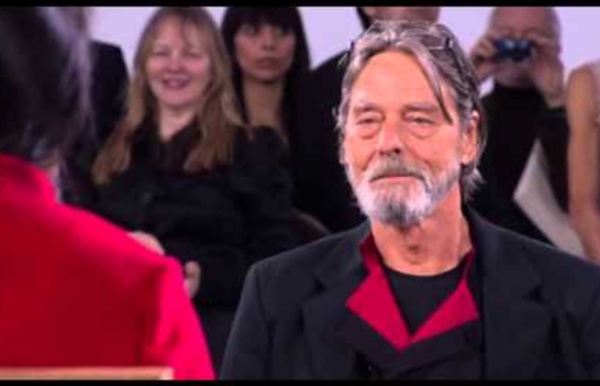



Bauhaus About Marina Abramović | Marina - A Documentary Film about Marina Abramović Marina Abramovic, born in 1946 in Belgrade, Yugoslavia, is without question one of the seminal artists of our time. Since the beginning of her career in Yugoslavia during the early 1970s where she attended the Academy of Fine Arts in Belgrade, Abramovic has pioneered the use of performance as a visual art form. The body has always been both her subject and medium. Exploring the physical and mental limits of her being, she has withstood pain, exhaustion, and danger in the quest for emotional and spiritual transformation. Abramovic's concern is with creating works that ritualize the simple actions of everyday life like lying, sitting, dreaming, and thinking; in effect the manifestation of a unique mental state. From 1975 until 1988, Abramovic and the German artist Ulay performed together, dealing with relations of duality. In 2005, Abramovic presented Balkan Erotic Epic at the Pirelli Foundation in Milan, Italy and at Sean Kelly Gallery, New York.
Sea of Skin Movement Performance Art Marina Abramovic, créatrice en Art corporel. Eléments d’une biographie 1Marina Abramović est née à Belgrade en 1946. Elle étudie à l’Académie des Beaux-Arts de Belgrade de 1965 à 1970 et choisit rapidement l’Art corporel. Elle s’est lacérée, flagellée, a congelé son corps sur des blocs de glace, pris des produits psycho-actifs et de contrôle musculaire, elle s’est mise en danger. Cependant, le but de cette artiste n’est pas le sensationnel. 2Ces actions se veulent des rituels de purification, conçus pour sa propre libération. Clio : Pour commencer, nous souhaiterions vous demander si vous vous considérez vous-même comme une sorte d’héroïne dans le domaine de l’art, ou si, tout simplement tous les artistes, tous les performeurs ne sont pas des héros ? MA : C’est une question vraiment très complexe car, pour ma part, en tant que personne privée, je ne me considère pas du tout comme une héroïne,en aucune façon car cela supposerait que je me place dans une position égale à celle d’un artiste avec un grand A. Clio : La création est-elle un acte héroïque ?
Body Interactions Abstract Expressionism On-line gallery A portrait of the Infanta Margarita, daughter of Felipe IV (1605-1665), surrounded by her servants or “family” in a hall of Madrid’s Alcázar Palace. This, the most famous of Velázquez’s works, offers a complex composition built with admirable skill in the use of perspective, the depiction of light, and the representation of atmosphere. There have been innumerable interpretations of this subject and later references to it. The most numerous emphasize a defense of the nobility of painting versus craft. The King and Queen, Felipe IV and María de Austria (1634-1696) are reflected in the mirror at the back of the room, leading to series of extraordinarily complex spatial relations.
Robert Rauschenberg Robert Rauschenberg (October 22, 1925 – May 12, 2008) was an American painter and graphic artist whose early works anticipated the pop art movement. Rauschenberg is well known for his "Combines" of the 1950s, in which non-traditional materials and objects were employed in innovative combinations. Rauschenberg was both a painter and a sculptor and the Combines are a combination of both, but he also worked with photography, printmaking, papermaking, and performance.[1][2] He was awarded the National Medal of Arts in 1993.[3] He became the recipient of the Leonardo da Vinci World Award of Arts in 1995 in recognition of his more than 40 years of fruitful artmaking.[4] Rauschenberg lived and worked in New York City as well as on Captiva Island, Florida until his death from heart failure on May 12, 2008.[5] Life and career[edit] Rauschenberg was born as Milton Ernest Rauschenberg in Port Arthur, Texas, the son of Dora Carolina (née Matson) and Ernest R. Canyon (1959) Death[edit] Combines[edit]
Museum - Exhibitions - Marina Abramovic: Seven Easy Pieces November 9, 5 PM to 12 AM Bruce Nauman, Body Pressure (1974). Nauman constructed a false wall nearly identical in size to an existing wall behind it. A pink poster with black typeface invited visitors to perform their own action by pressing against the wall. November 10, 5 PM to 12 AM Vito Acconci, Seedbed (1972). November 11, 5 PM to 12 AM VALIE EXPORT, Action Pants: Genital Panic (1969). November 12, 5 PM to 12 AM Gina Pane, The Conditioning, first action of Self-Portrait(s) (1973). November 13, 5 PM to 12 AM Joseph Beuys, How to Explain Pictures to a Dead Hare (1965). November 14, 5 PM to 12 AM Marina Abramović, Lips of Thomas (1975, Galerie Krinzinger, Innsbruck). November 15, 5 PM to 12 AM Marina Abramović, Entering the Other Side (2005). Funding for Seven Easy Pieces has been generously provided by the Marina Abramović Leadership Committee. ABOVE: Marina Abramović.
Robert Rauschenberg Biography American artist. Milton Ernst Rauschenberg was born on October 22, 1925, in Port Arthur, Texas. He studied at the Kansas City Art Institute (1946–7), the Académie Julien, Paris (1947), and with Josef Albers and John Cage at Black Mountain College, North Carolina (1948–50). Traveling widely, he was based in New York City from 1950, where he and Jasper Johns paved the way for pop art of the 1960s. He worked with the Merce Cunningham Dance Company, New York, as costume and stage designer (1955–64). An imaginative and eclectic artist, he used a mix of sculpture and paint in works he called ‘combines’, as seen in The Bed (1955). Throughout the 1980s and 1990s, he experimented with collage and new ways to transfer photographs.